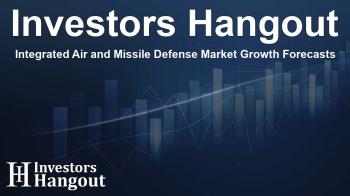Integrated Air and Missile Defense Market Growth Forecasts

Market Overview of Integrated Air and Missile Defense
The integrated air and missile defense (IAMD) market is on a significant upward trajectory, reflecting the increasing demand for advanced defense solutions. With an estimated value of USD 37.94 billion in the near-term and expectations to reach USD 68.38 billion by 2030, the market is projected to grow at a remarkable compound annual growth rate (CAGR) of 12.5%. This growth is largely driven by the need for resilient architectural systems aimed at countering new and diverse threats.
Key Market Drivers
One of the main factors propelling this market is the urgent requirement for robust systems that integrate radars, interceptors, and command platforms across various platforms, whether land-based, maritime, or airborne. The rising prevalence of asymmetric threats necessitates high-performance communication systems and improved data transfer technologies. Nations are prioritizing investments in command and control systems, electronic warfare solutions, and drone capabilities, resulting in significant advancements in integrated air defense functionalities.
Investment in Weapon Systems
Among the various components of the IAMD systems, weapon systems are emerging as the most vital segment. These systems are central to handling multiple aerial threats, including unmanned aerial vehicles (UAVs) and hypersonic missiles. Countries worldwide are heavily investing in the development and procurement of advanced interceptors and directed-energy weapons to protect critical infrastructures and enhance urban defense capabilities. By integrating kinetic and non-kinetic weapon systems, nations are ensuring extensive coverage against ever-evolving threats.
Focus on Medium-Range Defense Systems
The medium-range defense segment is anticipated to take the lead in this burgeoning market. Its capability to protect both front-line troops and strategic assets against a broad spectrum of aerial threats makes it an essential feature of national defense strategies. Medium-range air defense (MRAD) systems strike a fine balance between mobility, effectiveness, and cost, making them increasingly desirable in modernization efforts across military services. Systems such as Patriot, SAMP/T, and NASAMS are frequently noted for their significant roles in enhancing air defense capabilities.
Emerging Markets and Geopolitical Influences
The Middle East has been highlighted as one of the fastest-growing regions for integrated air and missile defense systems. This surge is largely attributed to rising geopolitical tensions and increasing missile threats that nations in the region face. Countries are investing in complex defense structures to shield essential infrastructures, including urban areas and oil facilities, from these imminent risks.
Strategic Relationships and Partnerships
Regional governments are seeking partnerships with leading global defense suppliers to upgrade their defense inventories. The urgency for comprehensive IAMD capabilities is evident in the procurement of advanced systems such as THAAD and Iron Dome, along with locally developed solutions. This strategic collaboration is vital for achieving rapid deployment of these critical defense systems, ensuring preparedness against potential threats.
Competitive Landscape
The key players in the integrated air and missile defense market include RTX, Lockheed Martin Corporation, MBDA, Northrop Grumman, and several others. These companies maintain strong distribution channels across North America, Europe, and the Asia-Pacific regions. Their continued innovations and investments are critical in addressing the challenges posed by varying aerial threats globally.
Future Trends and Opportunities
As the landscape of defense technology continues to evolve, the focus on integrated architectures will become increasingly pronounced. The demand for standardized IAMD systems that can operate seamlessly across multinational forces will drive the next wave of innovations in the market. Emphasis on the convergence of terrestrial, airborne, and space-based sensors is also anticipated to emerge as a key trend, bolstering the capabilities of defense systems.
Frequently Asked Questions
What is the projected size of the Integrated Air and Missile Defense market?
The Integrated Air and Missile Defense market is expected to reach USD 68.38 billion by 2030.
What are the main drivers behind market growth?
The growth is primarily driven by increasing investments in advanced weapon systems and the urgent need for enhanced defense capabilities against a variety of aerial threats.
Which segment is expected to dominate the market?
The weapon systems segment is anticipated to be the most dominant due to their critical role in neutralizing aerial threats.
How is the Middle East positioned in the IAMD market?
The Middle East is projected to be the fastest-growing region for integrated air and missile defense solutions, due to its rising geopolitical tensions and defense spending.
Who are the key players in the Integrated Air and Missile Defense industry?
Key players include RTX, Lockheed Martin, MBDA, and Northrop Grumman, among others, all of whom have established strong market positions.
About The Author
Contact Henry Turner privately here. Or send an email with ATTN: Henry Turner as the subject to contact@investorshangout.com.
About Investors Hangout
Investors Hangout is a leading online stock forum for financial discussion and learning, offering a wide range of free tools and resources. It draws in traders of all levels, who exchange market knowledge, investigate trading tactics, and keep an eye on industry developments in real time. Featuring financial articles, stock message boards, quotes, charts, company profiles, and live news updates. Through cooperative learning and a wealth of informational resources, it helps users from novices creating their first portfolios to experts honing their techniques. Join Investors Hangout today: https://investorshangout.com/
The content of this article is based on factual, publicly available information and does not represent legal, financial, or investment advice. Investors Hangout does not offer financial advice, and the author is not a licensed financial advisor. Consult a qualified advisor before making any financial or investment decisions based on this article. This article should not be considered advice to purchase, sell, or hold any securities or other investments. If any of the material provided here is inaccurate, please contact us for corrections.

